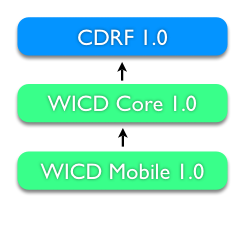The key words "MUST", "MUST NOT", "REQUIRED", "SHALL", "SHALL
NOT", "SHOULD", "SHOULD NOT", "RECOMMENDED", "may", and "OPTIONAL"
in this document are to be interpreted as described in
RFC 2119 (see http://www.ietf.org/rfc/rfc2119.txt). However,
for readability, these words do not appear in all uppercase letters
in this specification.
At times, this specification recommends good practice for
authors and user agents. These recommendations are not normative
and conformance with this specification does not depend on their
realization. These recommendations contain the expression "We
recommend ...", "This specification recommends ...", or some
similar wording.
-
Conformant WICD Mobile 1.0 user agents must implement the
"Compound Document by Reference Framework 1.0 (CDR 1.0)" including
the extended DOM API's and additional Events.
-
Conformant WICD Mobile 1.0 user agents must implement "WICD Core
1.0".
-
Conformant WICD Mobile 1.0 user agents must support XHTML Basic
1.1 as the root document.
-
Conformant WICD Mobile 1.0 user agents must support ECMAScript
3rd Edition Compact Profile (ES-CP) as a scripting language.
-
Conformant WICD Mobile 1.0 user agents must support the updated
version of CSS Mobile Profile 2.0.
-
Conformant WICD Mobile 1.0 user agents must support Scalable
Vector Graphics (SVG) Tiny 1.2 specification while referenced from
XHTML.
-
When declaring support for WICD Mobile 1.0, a conforming user
agent should use an "Accept" header with the value:
application/xhtml+xml;
profile="http://www.w3.org/2005/12/wicd-mobile".
-
Future versions of the WICD Mobile profile, which are compatible
with WICD Mobile 1.0, must use the same profile string, using the
same format, but with a later date.
-
Conformant WICD Mobile 1.0 user agents must support the Document
Object Model (DOM) Level 3 Core Specification subset defined in the
SVG Tiny 1.2 specification
[http://www.w3.org/TR/SVGMobile12/svgudom.html#dom] for all
namespaces.
-
Conformant WICD Mobile 1.0 user agents must support the features
described in Appendix C Document
Object Model (DOM) Level 3 Core Subset Extensions for all
namespaces.
-
Conformant WICD Mobile 1.0 user agents must support the Document
Object Model (DOM) Level 3 Events Specification Subset defined in
the SVG Tiny 1.2 Specification
[http://www.w3.org/TR/SVGMobile12/svgudom.html#events] for all
namespaces.
-
Conformant WICD Mobile 1.0 user agents must support the features
described in Appendix D Document
Object Model (DOM) Level 3 Events Extensions for all
namespaces.
-
Conformant WICD Mobile 1.0 user agents must support the Document
Object Model (DOM) Level 2 HTML Specification subset defined in
Appendix E Document Object Model (DOM) Level
2 HTML Subset for the nodes in the XHTML namespace.
-
In conformant WICD Mobile 1.0. user agents, the root
org.w3c.dom.Document instance must implement the FocusNavigation
interface defined in Appendix F Focus Traversal Support for
all namespaces.
-
Conformant WICD Mobile 1.0 user agents must support the SVG Micro DOM
(uDOM) specification for nodes in the SVG namespace.
-
Conformant WICD Mobile 1.0 user agents must support the
ElementTraversal interface on all DOM objects which implement
the org.w3c.dom.Element interface.
-
Conformant WICD Mobile 1.0 user agents must support the
DocumentView interface on all implementations of the
org.w3c.dom.Document interface.
-
In conformant WICD Mobile 1.0 user agents, the
org.w3c.dom.AbstractView associated with an org.w3c.dom.DocumentView
must be an implementation of the Window interface as defined in the
Window Object 1.0
specification.
-
Conformant WICD Mobile 1.0 user agents must support the
XMLHttpRequest Object.
-
Conformant WICD Mobile 1.0 user agents, for devices that have a
multi directional (2D) joystick input device, must implement a Two
Dimensional Focus Navigation with Flattened Children. For guidance
see Navigation
Models in WICD Core 1.0.
-
In a static situation, focus should go back to where it came
from, when a user navigates back.
-
Conformant WICD Mobile 1.0 user agents, should allow activation
of hierarchical child elements, using the "Ok" key.
-
Conformant WICD Mobile 1.0 user agents, implemented on devices,
that have at least two soft keys and no dedicated escape key,
should allow deactivation of hierarchical child elements, using
longpress Soft2.
